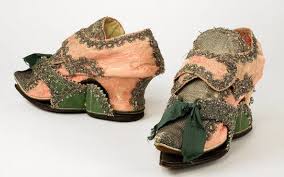Hope for Charity-Fashion/Accessories-Part 4
- sandykayslawsonWriter

- Apr 15, 2024
- 4 min read

Ladies' Shoes-Georgian Era England
The Cordwainer and Cobbler

The Cordwainer and Cobbler were popular career choices until the end of the 18th century when shoes were mass-produced.
Cordwainer: The English term for shoemakers, which originated from France
Shoemaker: Artisan who works with new leather to make shoes
Cobbler: Forbidden to work with new leather. They are the shoe repairmen, who must make their repairs with old leather
Today, one of the oldest livery companies in London is "The Worshipful Company of Cordwainers," which still trains young talent in the art of shoemaking. They have existed since 1439, with roots dating back to 1272.

Cobblers may not be as plentiful as in the past, but they aren't lost to us yet. There are those who hope to bring the nearly lost art back into popularity. Such as The Cobblers who mix the ancient art with a more modern "upcycling" approach, and Jim McFarland who is taking his family's 100-year-old cobbler business to Social Media.

"During the eighteenth century shoes and boots were made on straight lasts, or forms that created the soles of shoes, called straights. Without a sole designed specifically for the left or the right foot, shoes were uncomfortable. People frequently switched shoes from one foot to another to reduce the pain. Nevertheless, both men and women were expected to walk smoothly. Children began practicing how to walk properly in shoes from an early age."


"Shoes are complex objects. They were constructed by a number of differently skilled craftsmen using materials that had already undergone a number of processes before even reaching the shoemakers. In fact the materials contained in one shoe with uppers of silk and lined with tawed leather and linen would take up to three years in the processing not including the weaving of the fabrics."

Types of Shoes
"Women wore high-heeled shoes made of colorful silk or delicate leather, sometimes decorated with gold and silver lace and braid. Although women wore heavily decorated silk dresses, their shoes were rarely made from matching material; to do so would be much too expensive. Some shoes were laced, but most had decorative buckles. The toes of women's shoes were pointed or slightly rounded. These elaborate women's shoes were replaced at the end of the century, however, with much simpler styles, including the especially popular slipper."
Pattens
Can you imagine walking in such a contraption? No wonder ladies held on to the gentlemen's arms. It was a matter of life and death. 😂
The excerpt from the poem below is specifically talking about the Patten. Here is a link to the entire poem, but I'll warn you it is long, and the writer, John Gay, speaks a few times as if to a "goddess." When he died at 47 (1685-1732), I hope he had come to faith in the One and True God, The LORD, Father, Son, and Spirit, but unless some of his other writings speak of it, we have no way to know. In any case, I hope you will enjoy this excerpt and perhaps read the complete poem, which is rather humorous and interesting.
Trivia; Or the Art of Walking the Streets of London (Excerpt)
by John Gay (1716)
" . . . When blue ey’d Patty near his window came,
His anvil rests, his forge forgets to flame.
To hear his soothing tales she feigns delays;
What woman can resist the force of praise?
At first she coyly every kiss withstood,
And all her cheek was flush’d with modest blood:
With headless nails he now surrounds her shoes,
To save her steps from rains and piercing dews;
She lik’d his soothing tales, his presents wore,
And granted kisses, but would grant no more.
Yet winter chill’d her feet, with cold she pines,
And on her cheek the fading rose declines;
No more her humid eyes their lustre boast,
And in hoarse sounds her melting voice is lost.
This Vulcan saw, and in his heavenly thought,
A new machine mechanic fancy wrought,
Above the mire her shelter’d steps to raise,
And bare her safely through the wintry ways;
Straight the new engine on the anvil glows,
And the pale virgin on the patten rose.
No more her lungs are shook with drooping rheums,
And on her cheek reviving beauty blooms.
The god obtain’d his suit; though flattery fail,
Presents with female virtue must prevail.
The patten now supports each frugal dame,
Which from the blue-eyed Patty takes the name."
As a person who loves shoes, I could probably research this subject endlessly. However, I must draw this post to a close. Did you learn anything new? Did you see any shoes you loved or hated? What about those Pattens? I would love to hear what you think.
I truly appreciate all of my readers! Next time we will begin our look into men's clothing in the Georgian Era. I hope you will join us. If you are a new visitor, WELCOME! Please SUBSCRIBE, so you don't miss future posts and other updates.

April's Newsletter is Here!


.png)



















Very informative! The picture of the cobbler shop reminded me of our visit to Philadelphia to see my Uncle Dan’s mom, dad and 2 sisters! Immigrants from Italy the older couple could not speak English. His dad was a cobbler and stayed busy in his shop making shoes! His mom was busy making homemade pasta! All of this was fascinating to me as a very young girl!